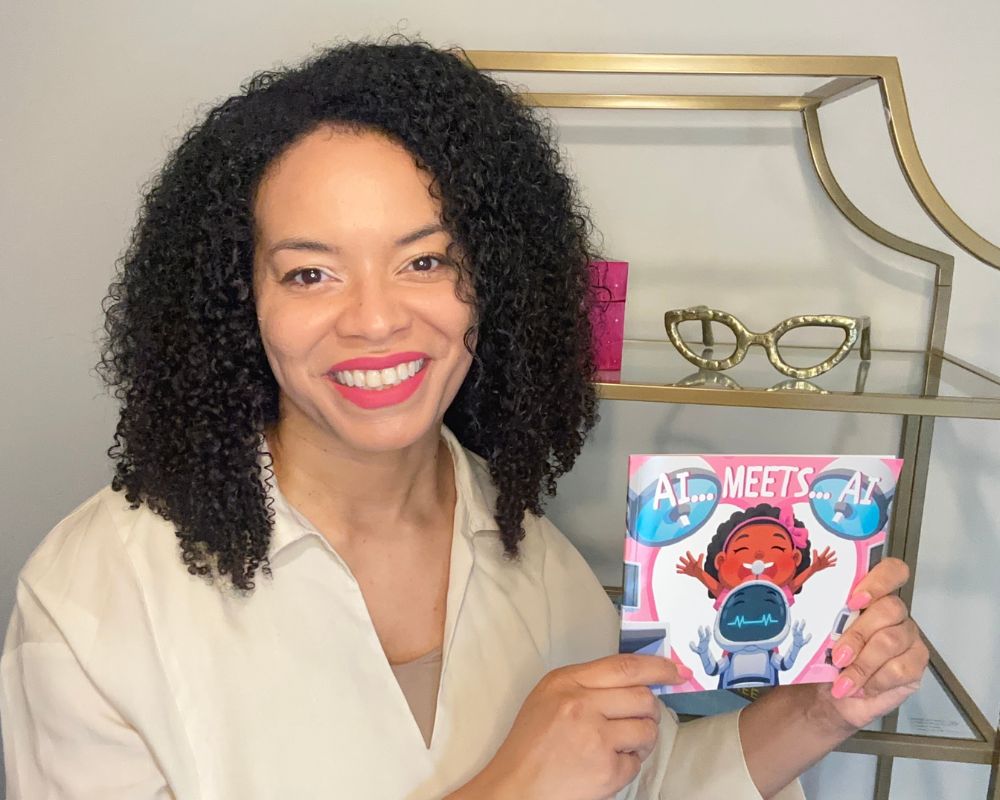In a world full of technology, books still matter — especially books about technology for kids.
For Baltimore-based Amber Ivey, who serves as the vice president of impact advisory at Social Finance, her debut children’s fiction book, “AI… Meets… AI: An Exciting Tale of Connection and Adventure,” reflects a “deeply personal mission” to empower diversity and inclusion in the tech sector.
“At its core, it revolves around the crucial concept of representation,” Ivey told Technical.ly in a recent interview. “The characters that come to life within its pages, strong and diverse, draw inspiration from the most significant individuals in my life: my nieces and my soon-to-be-born nephew, whose birthday is celebrated within the book’s narrative.”
Inspired by these loved ones, this children’s book revolves around historically underrepresented groups — girls and Black children — in STEM fields. Ivey’s vision is to challenge the prevailing narrative, empowering young readers to envision themselves in tech-centric roles and realize that their potential and dreams are boundless.
“With these characters, I sought to capture their vibrant spirit and unique identity, serving as a powerful reminder to them and others like them that they possess the capacity to lead in a world driven by technology,” she said.
The story’s plot focuses on Addy, a young girl who explores daily life and friendship through Baltimore with a learning AI entity named Jaz. While it’s meant for single-digit-aged children, “AI… Meets… AI” tackles themes like diversity and inclusion in tech, as well as the ever-evolving role of AI in daily life, that are relevant to people of all ages.
“The book challenges stereotypes by showcasing Addy, a young Black protagonist, leading an AI-driven adventure,” Ivey said. “The story highlights the vital role that everyone, regardless of gender or skin color, plays in shaping technology. It emphasizes the need for diversity in AI development to address biases.”
Ivey, who previously worked as a senior director at the Center for Government Excellence at Johns Hopkins University and a former analyst for Maryland StateStat, offers invaluable insights on the importance of embracing AI without hesitation. As someone who has contributed to Baltimore’s potential as a leading data city, Ivey now directs her attention to the intersection of data and people, particularly the younger generation. She firmly believes this is where meaningful and transformative change occurs. In the following Q&A, Ivey shares her thoughts on the significance of AI, the role of parents and educators and the power of empowering young minds. This interview has been lightly edited for length and clarity.
Why did you choose Black women and girls in Baltimore as the focal point for your story?
We live in a world where tech roles often lack diversity. There’s a glaring gap when it comes to women, especially Black women. So, in the story, I flipped the script. I placed female and Black characters in the driver’s seat of an AI-fuelled adventure. It’s a nudge to young readers, especially girls and children of color, to imagine themselves in these roles. I set the story in Baltimore, a city that perfectly encapsulates the stark contrasts we see in society. It’s a city where high-tech universities exist alongside areas still trying to tap into these advancements. The message? It doesn’t matter where you start – anyone can be a future leader in tech.
Apart from reading the book, how can parents or educators further engage children in understanding and exploring the AI concepts in your book?
While children might already encounter AI in their daily lives, from interacting with voice assistants to creating in digital platforms like Roblox, it’s important to explore AI beyond these experiences. Field trips to tech companies, science museums or university labs can bring the world of AI to life for children. Additionally, inviting local tech professionals or university students working on AI to chat with the kids can provide real-world perspectives and insights. Encouraging hands-on activities is another powerful way to engage children with AI. They can build simple robots with Lego sets, explore kid-friendly builder kits or even dream up their own app to solve real-world problems. The internet offers a wealth of resources to support their learning and exploration.
The goal is not to turn children into AI experts overnight, but rather to help them grasp a technology that will play a significant role in their future. This is why when it comes to AI, it’s crucial for parents and educators to actively embrace and learn alongside children, rather than shying away from it. To better understand AI, I’ve created a podcast called “AI Decodes the System,” which simplifies complex tech topics for adults.

This editorial article is a part of DEI Progress Month of Technical.ly’s editorial calendar.
Before you go...
Please consider supporting Technical.ly to keep our independent journalism strong. Unlike most business-focused media outlets, we don’t have a paywall. Instead, we count on your personal and organizational support.
3 ways to support our work:- Contribute to the Journalism Fund. Charitable giving ensures our information remains free and accessible for residents to discover workforce programs and entrepreneurship pathways. This includes philanthropic grants and individual tax-deductible donations from readers like you.
- Use our Preferred Partners. Our directory of vetted providers offers high-quality recommendations for services our readers need, and each referral supports our journalism.
- Use our services. If you need entrepreneurs and tech leaders to buy your services, are seeking technologists to hire or want more professionals to know about your ecosystem, Technical.ly has the biggest and most engaged audience in the mid-Atlantic. We help companies tell their stories and answer big questions to meet and serve our community.
Join our growing Slack community
Join 5,000 tech professionals and entrepreneurs in our community Slack today!

The person charged in the UnitedHealthcare CEO shooting had a ton of tech connections

From rejection to innovation: How I built a tool to beat AI hiring algorithms at their own game

Where are the country’s most vibrant tech and startup communities?




